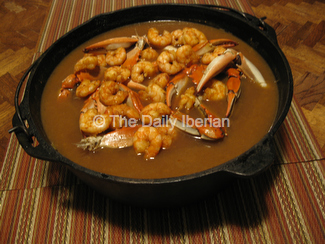Iconic dish
Published 8:22 am Thursday, October 11, 2012

- Seafood gumbo is the perfect one-dish winter meal.
Downtown New Iberia will soon take on the smell of gumbo as 96 cooking teams join in the “Battle of the Rouxs” for the 23rd World Championship Gumbo Cookoff set for Sunday. All will be trying to capture the bragging rights for the world’s best gumbo.
Mention the word “gumbo” in South Louisiana and it is sure to spark a conversation. Then the debate begins — What’s the perfect color for a roux? What’s the best seasoning? Is it a true Cajun-Creole gumbo without okra? Is store-bought roux acceptable?
The South Louisiana iconic dish has drawn much attention across the country.
Dig a spoon into a bowl filled with gumbo and it is anyone’s guess as to what is going to come out.
While some gumbo-lovers prefer a traditional chicken and sausage gumbo, others like seafood, squirrel, rabbit, duck, gumbo with okra or the unexpected gumbo with quail or alligator as the star ingredient. It has all become a matter of taste and creativity.
After nearly four years of research, Corey David Hotard, a contractor with Five River Services employed for the National Wet Land Research Center, who is also working toward a doctorate, can attest to the old adage — no two gumbos are alike, even if the same person is cooking it.
Beyond the basic roux or filé used as a thickener, there are no hard and fast rules as to what goes into a gumbo pot or the way it is prepared.
Hotard, who selected Cajun food for his dissertation, opted to focus on gumbo for a Geographic Information System mapping project to correlate between gumbo recipes and physical geographic regions of Acadiana.
Hotard said when he approached his professor with the idea, his professor challenged him that there would not be enough variations in gumbo to form a Foodway Path among the geographical areas.
Once Hotard started the research, he became amazed at the number of variations in the iconic dish.
Through interviews, regional cookbook research and recipe questionnaires, Hotard came to the conclusion there are as many ways to cook gumbo as there are people in Louisiana.
As part of a computer mapping project, Hotard was looking for patterns in recipes in the geographical areas of the central Acadiana region, New Orleans and Lake Charles. He was looking for similarities between the river, prairie and coastal areas.
Hotard reached out to friends and family asking for chicken and sausage gumbo recipes. After receiving 106 recipes, Hotard narrowed his research comparison to include 70 recipes within his geographical research area.
In a comparison of the 106 chicken and sausage recipes submitted, all were different.
“There were no two the same. There were differences in types of sausage used in the recipe, amount of meat used, roux color, seasonings and cooking times,” said Hotard.
Although the project was about statistic comparisons in geographical areas, Hotard said he soon came to realize more of the cultural aspect of the dish as he conducted interviews.
Hotard has conducted nearly 100 interviews since his curiosity over Cajun food peeked.
Hotard, 35, said he had relocated to Tampa in 2005 and began to crave some Cajun food. Being an unexperienced cook, he decided to learn to cook some simple dishes.
“I pretty much learned to cook gumbo over the phone. I’d call my mom and ask for some tips,” said Hotard.
After returning to his New Iberia home, Hotard said he didn’t stop cooking. He became more intrigued by the history of Southern food and the cooks in the area.
Hotard’s research showed these varying characteristics among gumbo cooks in the three areas he did comparisons:
• Eastern Acadiana: Gumbo cooks are more likely to use lighter roux, include smoke sausage, use more spices and use filé.
• Central Acadiana: Gumbo cooks are more likely to cook a roux with equal ration of flour to oil, use more vegetables and have a longer cooking time.
• Western Acadiana” Gumbo cooks use dark roux with an equal ration of flour to oil and cooking time is generally two hours.
Color of the roux seemed to be one of the most important distinguishing factors, he said. “The color of the roux ranged from light peanut butter in color to dark chocolate,” said Hotard.
“Then you have ‘Gumbo Z’herbes’ or sometimes called ‘Green Gumbo’ which is made with mustard greens or turnips greens.”
Hotard said one of his favorite interview spots is Bouligny Plaza for the Greater Iberia Chamber of Commerce World Championship Gumbo Cookoff.
“For the past four years, the chamber has allowed me to interview the cooks to help in my research,” he said. “I like to hear the stories behind the gumbo recipes and their origins.”
Hotard said when he started his research, he was hoping to find the answer as to why gumbo is so entrenched in the culture of South Louisiana.
“It is not just Creole and Cajun cultures that have influenced the dish. It is any culture that has inhabited in South Louisiana. The Filipinos also have a claim to the dish. They introduced the use of dry shrimp into gumbo in South Louisiana,” said Hotard.
“There is such a conglomerate of cultures in South Louisiana and because of that every ethnic group here has influenced the dish. Even though gumbo is found in other culinary traditions, it is considered an emblematic Cajun dish,” he said.
The three-day cookoff starts with live music on Friday night, and a Creole food festival on Saturday, followed by the main event on Sunday when gumbo will be served by the 96 cooking teams competing for the coveted title in amateur and professional divisions in seafood and non-seafood categories.
Gumbo tasting begins at 11 a.m. A variety of gumbos will be available for tasting. Tickets are $4 for seafood and $3 for non-seafood.
For more detailed information visit www.iberiachamber.org/gumbo-cookoff or call the Greater Iberia Chamber of Commence at 364-1836.





